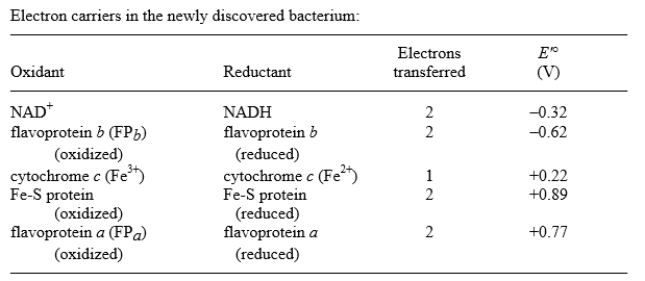Not Answered
A recently discovered bacterium carries out ATP synthesis coupled to the flow of electrons through a chain of carriers to some electron acceptor. The components of its electron transfer chain differ from those found in mitochondria; they are listed below with their standard reduction potentials.  (a) Place the electron carriers in the order in which they are most likely to act in carrying electrons. (b) Is it likely that O2 (for which E'° = 0.82 V) is the final electron acceptor in this organism? Why or why not? (c) How would you calculate the maximum number of ATP molecules that could theoretically be synthesized, under standard conditions, per pair of electrons transfered through this chain of carriers? (The Faraday constant,
(a) Place the electron carriers in the order in which they are most likely to act in carrying electrons. (b) Is it likely that O2 (for which E'° = 0.82 V) is the final electron acceptor in this organism? Why or why not? (c) How would you calculate the maximum number of ATP molecules that could theoretically be synthesized, under standard conditions, per pair of electrons transfered through this chain of carriers? (The Faraday constant,  , is 96.48 kJ/V · mol.) G'° for ATP synthesis is +30.5 kJ/mol.
, is 96.48 kJ/V · mol.) G'° for ATP synthesis is +30.5 kJ/mol.
Correct Answer:

Verified
Correct Answer:
Verified
Q76: In some organisms, an alternative oxidase will
Q77: During electron transfer through the mitochondrial
Q78: Compound X is an inhibitor of mitochondrial
Q79: In normal mitochondria, the rate of NADH
Q80: A new compound isolated from mitochondria is
Q82: The compound 2,4-dinitrophenol (DNP), an uncoupler, was
Q83: What is the role of cytochrome c
Q84: How many molecules of water are produced
Q85: Which statement explains why the [ATP]/[ADP][P<sub>i</sub>] ratio
Q86: During the operation of the malate-aspartate shuttle,